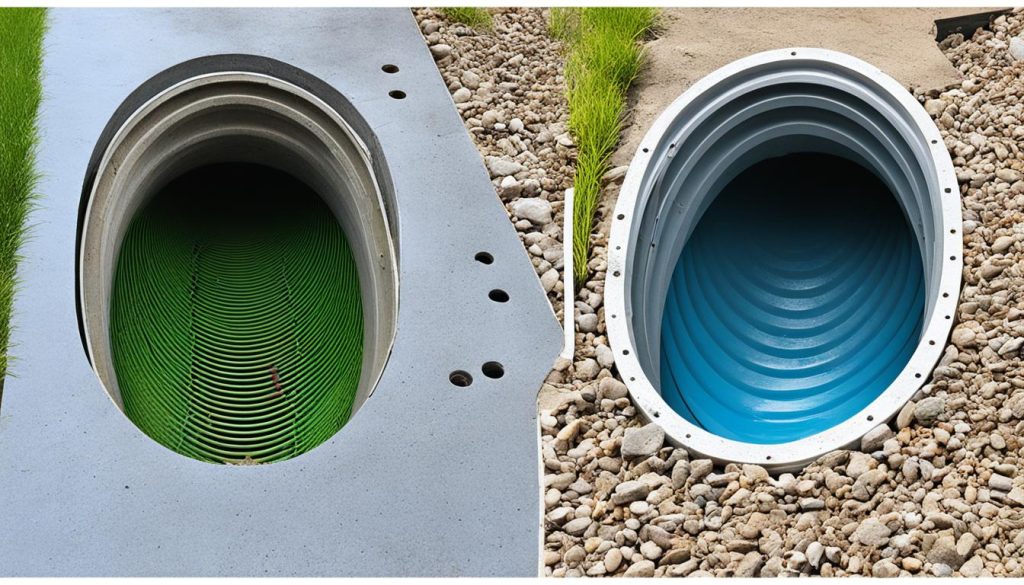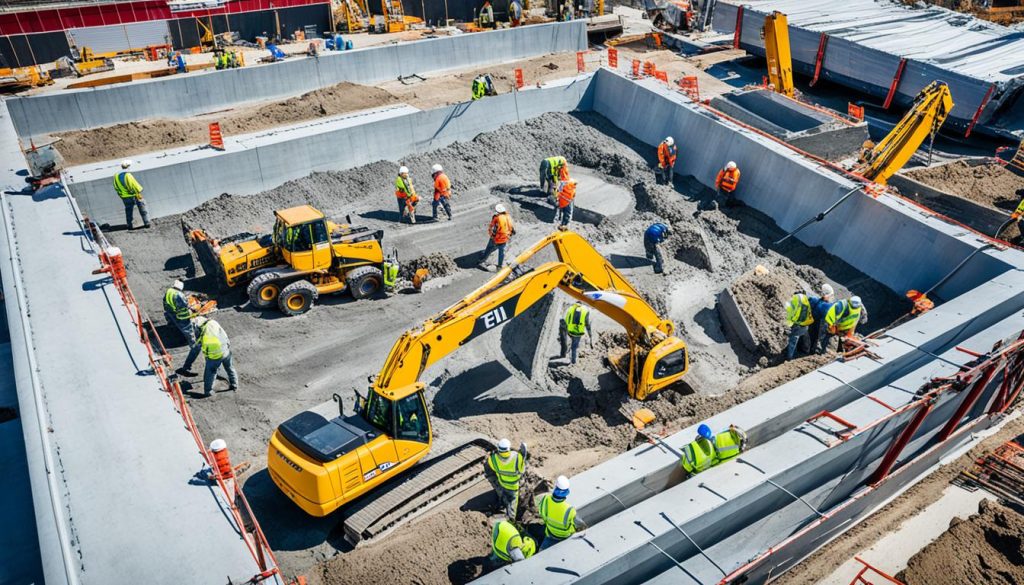Relocating Concrete Slab Drains Simplified
Did you know that every year, thousands of homeowners and businesses in Canada face the challenge of moving a drain in a concrete slab? Whether it’s due to remodeling projects, plumbing upgrades, or other renovations, the need to relocate a drain can arise unexpectedly.
But fear not! I’m here to tell you that relocating a drain in a concrete slab doesn’t have to be a daunting task. With the right approach and proper planning, you can simplify the process and ensure a successful outcome. In this article, we will delve into expert tips and advice on how to effectively move a drain in a concrete slab, including the use of drain relocation services.
Key Takeaways:
- Relocating a drain in a concrete slab can be challenging, but with the right approach, it can be simplified.
- Proper planning and consultation with drain relocation services are crucial for a successful project.
- Consider the challenges of concrete slab repair, waterproofing, and ongoing maintenance when moving a drain.
- Different methods, including slot drain systems, can be used for drain relocation in concrete slabs.
- Ensure proper installation, leveling, and finishing touches to maximize the functionality and longevity of the relocated drain.
Challenges of Moving a Drain in a Concrete Slab
When considering the relocation of a drain in a concrete slab, it is important to be aware of the challenges that may arise. These challenges include the need for concrete slab repair, ensuring proper waterproofing to prevent leakage, and ongoing maintenance of the concrete slab.
Concrete slab repair plays a vital role in ensuring the structural integrity of the slab. Over time, concrete slabs can develop cracks, which can compromise the stability of the drain and its surrounding area. Addressing any existing cracks and performing necessary repairs before relocating the drain is crucial to prevent future issues.
Proper waterproofing is another challenge that needs to be addressed when moving a drain in a concrete slab. Without effective waterproofing, water can seep through the slab and cause damage to the surrounding areas. This can lead to moisture-related problems such as mold growth, deterioration of the concrete, and even structural damage.
Ongoing maintenance of the concrete slab is essential to ensure the longevity and functionality of the relocated drain. Regular inspection of the slab, checking for any signs of deterioration or damage, and addressing them promptly can help prevent costly repairs down the line.
By considering these challenges and taking appropriate measures, such as concrete slab repair, waterproofing the slab, and implementing regular maintenance, you can successfully navigate the process of moving a drain in a concrete slab. Consulting with professionals experienced in concrete slab repair and drain relocation can provide valuable guidance to ensure a smooth and efficient relocation process.
Different Methods for Drain Relocation in Concrete Slabs
Relocating a drain in a concrete slab can be a complex task, but there are various methods available to accomplish it effectively. Drainage system relocation often entails digging up part of the floor to reroute the waste pipe. However, innovative solutions like slot drain systems can provide alternative options. Consulting experienced drain relocation contractors is crucial to determine the most suitable method for your specific situation.
When considering drain relocation in concrete slabs, it is essential to assess the feasibility and effectiveness of different approaches. Working with professionals who specialize in drainage system relocation can ensure the successful execution of your project. These contractors have extensive expertise, allowing them to evaluate the best method for relocating drains in concrete slabs based on various factors such as the layout of the slab, underlying plumbing, and overall project requirements.
Whether you choose to excavate and reroute the waste pipe or opt for slot drain systems, it is crucial to consider the long-term durability and functionality of the relocated drain. By partnering with drain relocation contractors, you can benefit from their knowledge and experience in assessing the structural integrity of the concrete slab and ensuring seamless integration of the relocated drain into the overall drainage system. These professionals can provide invaluable insights and guidance throughout the process, helping you avoid potential pitfalls and maximize the efficiency of your drainage system relocation.
https://www.youtube.com/watch?v=OIcVcJvUadc
Pros and Cons of Different Drain Relocation Methods in Concrete Slabs
| Method | Pros | Cons |
|---|---|---|
| Digging and Rerouting |
|
|
| Slot Drain Systems |
|
|
Advantages of Slot Drain Systems for Drain Relocation
When it comes to drain relocation in concrete slabs, slot drain systems offer numerous advantages. These innovative systems are pre-sloped and pre-assembled, making them incredibly easy to install. Whether you’re renovating a commercial space or remodeling your home, slot drain systems provide a sleek and functional solution for concrete slab remodeling projects.
One of the key advantages of slot drain systems is their discreet footprint. Unlike traditional drains that can be bulky and obtrusive, slot drains are designed to seamlessly blend into the surrounding concrete. This not only enhances the aesthetics of your space, but it also promotes worker safety by minimizing the risk of tripping or other accidents.
Additionally, slot drain systems are highly customizable, allowing you to choose the dimensions and materials that best suit your project. Whether you need a drain for a high-traffic area or a specific design requirement, slot drain systems can be tailored to meet your exact needs.
Furthermore, these systems are highly durable and low maintenance. Made from durable materials such as stainless steel or polymer concrete, slot drain systems can withstand heavy foot traffic and resist corrosion. With minimal maintenance required, you can enjoy peace of mind knowing that your drain will continue to perform optimally for years to come.
The Advantages of Slot Drain Systems:
- Easy installation with pre-sloped and pre-assembled components
- Discreet footprint for enhanced aesthetics and worker safety
- Customizable dimensions and materials
- Durable and corrosion-resistant
- Low maintenance
Overall, slot drain systems offer a range of benefits for drain relocation in concrete slabs. Their ease of installation, aesthetically pleasing design, and low maintenance requirements make them an excellent choice for any concrete slab remodeling project.
Planning and Execution of Drain Relocation in Concrete Slabs
When it comes to relocating a drain in a concrete slab, thorough planning and execution are key to a successful project. Whether you’re remodeling your concrete slab or need to relocate a drain for functional purposes, it’s important to approach the process carefully and consider various factors.
To begin, marking the outline of the drain on the existing concrete slab is crucial. This will help you visualize the area and ensure accuracy when choosing the proper drain system for relocation. It’s important to select a drain system that meets your specific needs, taking into account factors such as drainage capacity and compatibility with your existing plumbing system.
Precise measurements are essential to ensure a seamless transition when relocating a drain in a concrete slab. This includes measuring the depth of the concrete slab to determine the required length of the drain pipe and positioning of the new drain. Taking these measurements accurately will help avoid any complications during the installation process.
Working with experienced drain relocation contractors is highly recommended. They have the knowledge and expertise to guide you through the planning and execution stages of your project. Drain relocation contractors can provide insights on the best practices for drain relocation in concrete slabs and help you navigate any potential challenges along the way.
Benefits of Hiring Drain Relocation Contractors
- Expertise in drain relocation techniques
- Access to specialized tools and equipment
- Efficiency and time-saving
- Compliance with building codes and regulations
- Professional advice and support
By working with drain relocation contractors, you can ensure that your drain relocation project is carried out efficiently and according to industry standards. They will handle the planning, execution, and any necessary adjustments to ensure a successful outcome.
Remember, proper planning and execution are crucial for the smooth relocation of a drain in a concrete slab. Partnering with experienced drain relocation contractors will provide you with the expertise and guidance needed to overcome challenges during the process.
Ensuring Proper Installation and Leveling of the Drain
When it comes to the installation and leveling of a drain in a concrete slab, attention to detail is essential. By following these steps, you can ensure the functionality and longevity of your drain:
- Prepare a sturdy foundation: To provide proper support for the drain, create a concrete slab for it to rest on. This will help distribute the weight evenly and prevent any future issues.
- Reinforce the sidewalls: To avoid bowing or cracks in the concrete slab, reinforce the sidewalls surrounding the drain. This step is critical in maintaining the structural integrity of the installation.
- Level the drain: Achieving a level surface is crucial for the drain’s functionality. Ensure that it is properly aligned to prevent any protrusions or uneven water flow. This will create a seamless transition between the drain and the surrounding concrete slab.
- Anchoring the drain: To prevent future damage or displacement, it is recommended to pour a final layer of concrete around the drain, anchoring it securely in place.
Properly installing and leveling the drain will not only enhance its performance but also contribute to the overall durability of your concrete slab. By following these steps, you can minimize the risk of future repairs and ensure the longevity of your drain system.
Caption: Image depicting the correct installation and leveling of a drain in a concrete slab.
Finishing Touches and Testing the Drain
Once the drain has been successfully installed and the concrete has dried and cured, it’s time to add the finishing touches to ensure a smooth and functional drain system. First, remove any protective wrapping or coverings from the drain to reveal its pristine condition. This will allow you to inspect the drain and ensure that it is free from any obstructions or damage.
The next step is to thoroughly test the functionality of the drain. Pour water into the drain and observe its flow. Check for any leaks or blockages that may impede the drainage process. This step is crucial to verify that the drain is working efficiently and can effectively handle the volume of water it will encounter.
Regular maintenance of both the concrete slab and the relocated drain is essential to preserve their long-term efficiency. This includes routine cleaning to prevent buildup of debris or contaminants that can obstruct the drain. Additionally, inspect the drain periodically to identify any signs of wear or damage that may require repair or replacement.
To ensure proper maintenance and ongoing support for your drain system, it is highly recommended to consult drain relocation services. These professionals have extensive experience in drain relocation and can provide expert guidance on maintenance practices and potential issues to look out for. By partnering with drain relocation services, you can ensure that your drain system operates at its best for years to come.
- Investing Wisely: How Windows & Doors in Boost Property Value and Financial Health - April 24, 2025
- The Financial Impact of Personal Injuries: Why Legal Help Matters for Business Owners - April 16, 2025
- The Hidden Financial Costs of Domestic Assault: What Business Owners Need to Know - April 16, 2025














